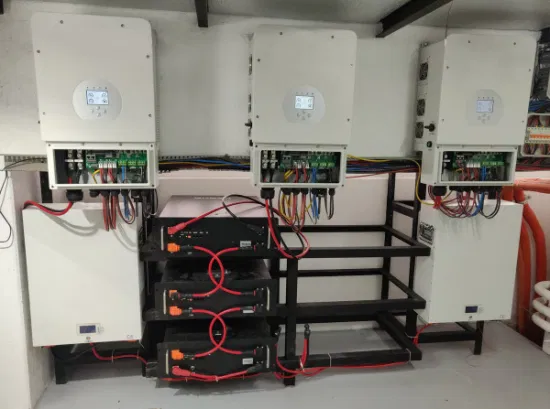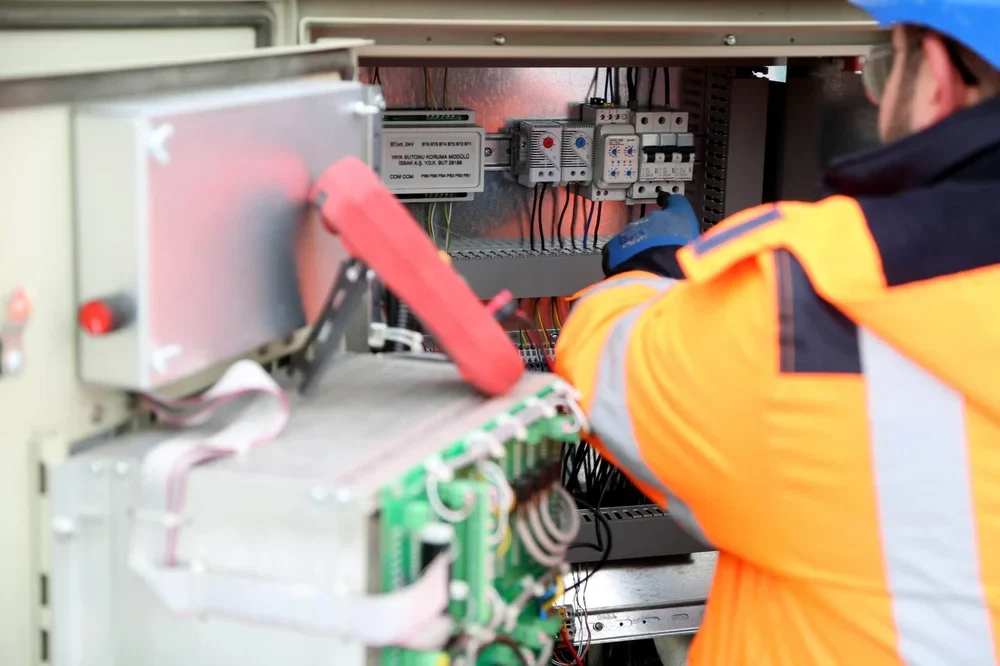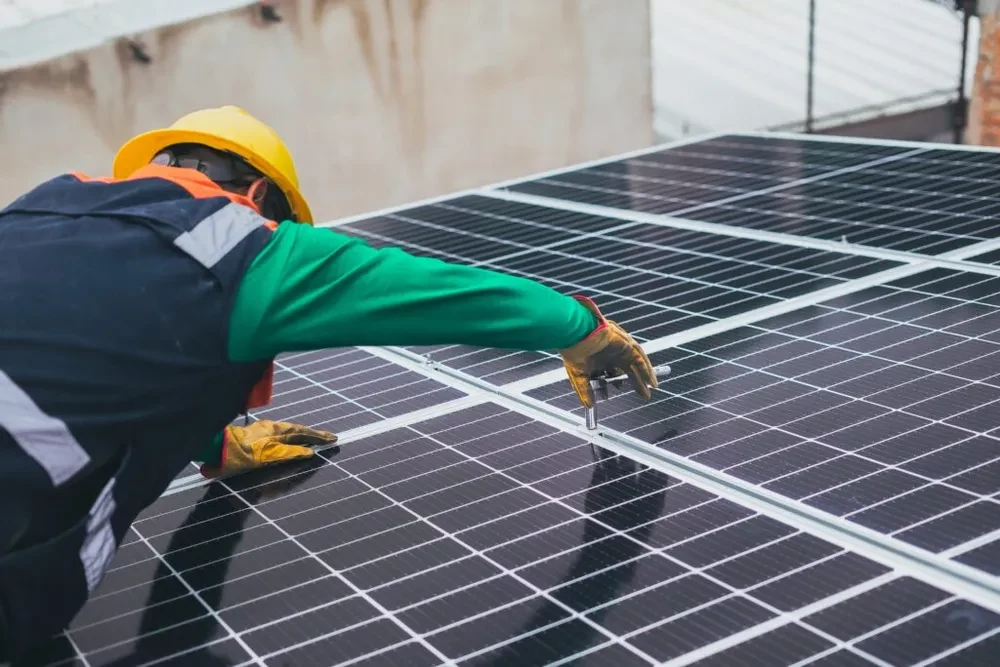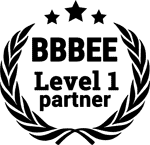Running parallel inverters essentially increases the power capacity, optimizing the performance of the system. In a solar panel setup, this allows for a more efficient harnessing of renewable energy.
It’s crucial to follow the manufacturer’s instructions to ensure compatibility and safety, as not all inverters are designed for parallel operation.
The process includes connecting the positive and negative outputs of both inverters and then connecting them to the battery bank. The AC outputs are also connected in parallel to increase the total power supply to the load.
It’s important to note that the inverters must have the same voltage and frequency settings before a successful parallel connection can be achieved. It is advisable to seek professional help when trying to connect two inverters in parallel.
Understanding Inverters: Can You Connect 2 Together?

The process of connecting inverters in parallel is intricate and must be done with utmost caution because the output may fluctuate if not properly managed. If this happens, it could potentially damage the battery bank.
Connecting 2 inverters in parallel entails matching both inverters’ voltage and frequency parameters to ensure synchronized operation. This compatibility largely depends on the manufacturer’s specifications. A failure to properly match these parameters can not only reduce the system’s effectiveness but may also cause safety issues. When trying to connect inverters in parallel, the role of the battery bank is essential. It serves as a buffer that helps balance the load and secure a smooth operation of the parallel connection.
Despite the promise of increased power output, undertaking this process requires careful planning and execution to ensure safety and efficiency. Connecting inverters in parallel should ideally be performed by a professional electrician or solar installer to guarantee a safe and efficient installation
The Feasibility of Connecting Inverters in Parallel
Running inverters in parallel also promotes redundancy in case one of them fails, ensuring a continuous power supply. This redundancy, coupled with the potential increase in power capacity, boosts your energy system’s reliability.
Setting up inverters in parallel should be carried out by a qualified electrician or a certified solar installer to guarantee that the inverters are properly wired and the connection is safe.
The additional output power provided by the parallel connection of inverters is beneficial for households or businesses looking for increased power capacity. While a parallel connection of inverters demands careful execution, when done correctly, it can maximize the efficiency of solar inverters and their overall power output.
Key Points About Parallel Connection of Inverters
- Parallel connection of inverters can enhance the performance of the overall solar power system by distributing the power load more efficiently.
- Running inverters in parallel provides redundancy, ensuring a continuous power supply even if one inverter fails.
- Setting up inverters in parallel should be done by a qualified electrician or a certified solar installer to ensure proper wiring and safety.
- The additional output power provided by the parallel connection of inverters is beneficial for households or businesses looking for increased power capacity.
Power Amplification: Using Two Inverters in Parallel
Harnessing the sun’s energy to power our homes has gained vast worldwide support, with many homeowners investing in solar panels and parallel inverters to improve their power supply. As a result, understanding how we can maximize solar panel system efficiency is crucial.
An inverter is a device that converts direct current (DC) from solar panels into alternating current (AC), powering most household appliances. Power amplification using two inverters in parallel is a safe and efficient method that improves power output and system reliability.
Power amplification works on the principle of multiple device connections, whose combined outputs yield higher power than a single device. When two inverters operate harmoniously together, there is a significant boost to the power they produce and, consequently, your power supply.
Parallel Connection of Inverters: Increasing Output Power

It is advisable to run two inverters together, connecting them in parallel to maximize the efficiency of your solar panel system and allow for a higher energy output. This way, your solar power system can still operate, even if one inverter is out of action.
As the direct current from the solar panel is converted into alternating current by the inverters, the energy supply is increased. This is particularly beneficial in larger solar systems, where a single inverter might not have the capacity to handle the total power generated from the solar panels.
A parallel connection of inverters is not limited to just two inverters, either. Multiple inverters can be connected, further enhancing the power supply to meet even larger energy requirements.
However, it’s important to ensure that the inverters are properly designed for parallel connection and that the connection is performed correctly. An inaccurate setup could risk damage to the inverters or even the entire solar power system, specifically when trying to run 2 inverters together or trying to connect two inverters in parallel.
Advantages of Parallel Connection of Inverters | Potential Risks
Redundancy: Ensures that solar power system can still operate if one inverter fails | Inaccurate setup: Could risk damage to the inverters or the entire solar power system
Increased Energy Output: Allows for a higher energy output as the energy supply is increased | Design Compatibility: Inverters must be properly designed for parallel connection
Scalability: Multiple inverters can be connected to meet larger energy requirements | Connection Process: The connection must be performed correctly to avoid potential damage
Battery Connection: Running Inverters in Parallel via Battery Bank
A significant challenge is ensuring that each inverter is working at its optimal potential, especially when connecting multiple inverters in a solar power system to maximize output. This requires precise calibration and maintenance of all the connected inverters.
If one inverter operates at a higher or lower capacity than the others, the system might fail or deliver unsatisfactory performance.
In a parallel connection of inverters, it is crucial to make the right connections. The positive end of one inverter is connected to the positive end of the next one while the negative end is connected to the negative end of the other. This ensures a balanced power supply from the battery bank.
When connecting two or more inverters in a parallel configuration, the cables should be of equal length and diameter to avoid power loss. It is also advisable to follow the manufacturer’s instructions strictly when configuring the connections.
It’s essential to make correct parallel connections for the most efficient use of a solar power system, particularly when connecting multiple inverters to increase output and maintain a stable voltage in the battery bank.
Solar Power Boost: How to Connect Two Solar Inverters in Parallel

An electrician or solar installer has the technical expertise to ensure that the inverters are properly set up and that all safety measures are observed.
Moreover, it’s important to heed the manufacturer’s instructions. The manufacturer’s guide will give details on how to connect the inverters in parallel correctly. Not following these guidelines can void warranties and risk damaging your solar power system.
Connecting inverters in parallel can provide redundancy. If one inverter fails, the other can continue producing power, preventing a complete power blackout. This redundancy is especially beneficial in power-critical environments.
The voltage and current of the power supply should also match those of the inverters. If the supply voltage is too low or the current too high, this could damage the inverters. As such, make sure to use the parallel operation method when connecting multiple inverters to increase redundancy and total power output.
Mastering the Art of Connecting Multiple Inverters Together
When connecting two inverters to produce an amplified power supply, ensure that the inverters are correctly aligned according to the manufacturer’s instructions. This guarantees an increased power capacity and the potential to employ this in off-grid, renewable energy systems. This task requires careful attention to detail and a solid understanding of the equipment’s dynamics.
Because of how complex the process can be, It is crucial to adhere to the manufacturer’s instructions to ensure a seamless integration of inverters. This integration not only maintains but also maximizes the generated power capacity.
This process is applicable beyond off-grid setups, including renewable energy sources. Anyone planning to connect multiple inverters should understand the principles of series connection for optimal performance.
Creating a Robust Power Supply: Parallel Connection of Power Inverters
Venturing into parallel configurations, it is essential to understand the function of a power inverter. This is particularly useful when trying to manage the ac output and output voltage from multiple solar inverters in parallel within a solar system. This converter transforms direct current (DC) derived from your solar system into alternating current (AC), making the operation of electrical appliances possible.
The process of connecting the positive terminals of multiple solar inverters in parallel amplifies the power output, extending your system’s capabilities. The increased power supply stems from the sum of AC output produced by all the connected inverters, enhancing your power source system’s strength.
This approach requires thorough planning. It’s important to ensure compatibility among inverters, maintain a consistent output voltage, and understand the power capacities of each unit.
When connecting batteries, special attention is needed to maintain a consistent power flow.
Leveraging the potential of parallel inverter connections marks a significant progression in renewable energy applications
The Role of Output Voltage in Connecting Inverters in Parallel
Harnessing the natural power of the sun through multiple solar inverters requires an accurate balance of output voltage for efficient energy conversion. Because of this, compatible inverters must be properly connected in a parallel configuration by a certified electrician or solar installer. When two inverters are connected in parallel, the system’s stability and optimal performance depend on the output voltage.
Renewable energy often acts as a universal stabilizer, particularly while linking several solar inverters. Any imbalance can lead to system instability or, worse, failed power output.
To prevent this, compatible inverters must be hooked up and overseen by an expert electrician or solar installer. These professionals ensure the right installation of inverters, resulting in balanced outputs.
For off-grid systems, consistently managing output voltages across parallel connections is critical
Expert Advice: When to Connect Two or More Inverters

Renewable energy systems, notably those employing solar power, have greatly altered our energy consumption habits by making it possible to connect multiple inverters to a single battery storage system. This greatly enhances the efficiency and flexibility of our energy use.
Understanding how to connect multiple inverters, such as solar, AC, and DC power inverters, to a single battery canal is vital. It might appear simple, but linking two or more units of three-phase inverters calls for intricate knowledge about their compatibility and the impact on the overall system’s performance.
While each inverter comes with a manufacturer’s guide, these instructions are often difficult for a non-professional to understand. Therefore, consulting with a professional electrician or a solar installer can be beneficial. Inappropriate connections might lead to system failure, redundancy, or an underperforming renewable energy system.
Inverters should always be connected in a series to maintain the stability of the power output and to prevent voltage fluctuations
Key Points on Connecting Multiple Inverters to a Single Battery System
- Connecting multiple inverters to a single battery system enhances the efficiency and flexibility of energy use, particularly in renewable energy systems such as solar power.
- Linking two or more units of three-phase inverters requires detailed knowledge about their compatibility and the potential impact on the overall system’s performance.
- While each inverter comes with a manufacturer’s guide, these instructions can be complex for non-professionals to understand, making consultation with a professional electrician or solar installer beneficial.
- Inappropriate connections can lead to system failure, redundancy, or an underperforming renewable energy system. Therefore, inverters should always be connected in a series to maintain the stability of the power output and prevent voltage fluctuations.
Safety Measures: Ensuring Proper Connection of Multiple Inverters
Knowledge about the inverter types, their output voltage, and the correct way to connect the batteries is essential when connecting multiple inverters, especially in case one of them fails or when planning to run 2 inverters together. In general, the connection involves linking the positive outputs of both inverters and the negative outputs of both inverters to the battery bank.
It is important to note that the input voltage of the inverters must be the same, and the inverters must be of the same model and manufacturer. One of the advantages of connecting inverters in parallel is that the total power of the system increases.
If, for instance, you have two inverters with an output power capacity of 500 watts each, connecting them in parallel would give you an output power of 1000 watts. This increased power output is useful in off-grid solar power systems.
Connecting multiple solar inverters in parallel is a common practice in renewable energy projects, especially because it allows the system to work in parallel and ensures continuous power supply in case one of them fails.
Boosting Power Capacity by Adding Another Inverter to Your System

The possibility of linking two or more inverters together is based on the use of AC inverters. Although this may sound complex, it refers to a parallel configuration that involves the connection of the positive outputs from each inverter. This effectively enhances the total power output of your system, taking its capacity to higher levels.
To ensure a safe and efficient process, it’s crucial to hire an experienced electrician or solar installer. They can adeptly handle every part of the process, from the DC power source to the installation of necessary circuit breakers.
This technical approach is critical to ensure that your installation operates at its optimal level. The process of enhancing power makes use of inverters to convert direct current to alternating current, thus ensuring an increased power output.
Key Points About Power Enhancement Using Inverters
- Connecting positive and negative wires from a DC power source to AC inverters can increase power output and preserve the integrity of the existing system’s circuit breakers.
- Linking two or more AC inverters together, in a parallel configuration, can significantly enhance the total power output of a system.
- For a safe and efficient installation process, it is crucial to involve an experienced electrician or solar installer. They can adeptly handle every part of the process.
- Inverters are essential in converting direct current to alternating current, which is a key process in enhancing and increasing power output.



